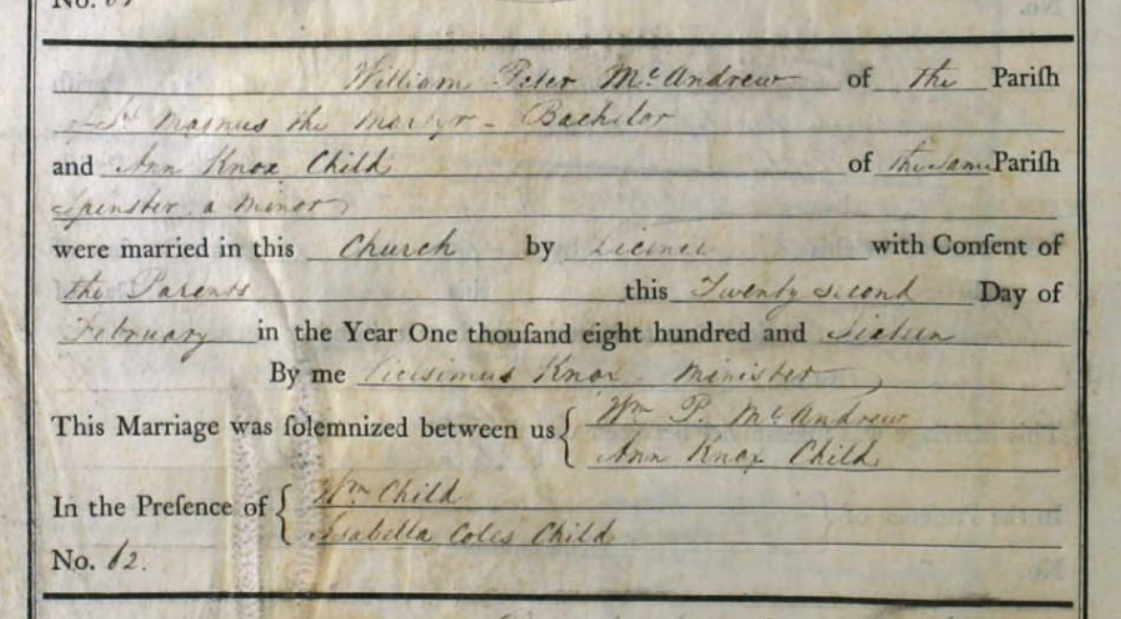THE MCANDREW FAMILY
William Peter McAndrew joined the family firm which dealt in fruit from Spain and Portugal. He lived in Bell House with his wife and children.
William Peter McAndrew was born on 25 July 1790 on Lower Thames St, the son of William McAndrew, a Scot who had arrived in London aged 18 to seek his fortune, and his wife Antonia Sykes. William McAndrew senior had started a business importing fruit from Spain, Portugal and the Azores and soon opened premises at 1 Lower Thames St, London, a prime trading site right next to one of the Legal Quays, through which all Port of London merchandise had to be funnelled. Later he later opened another warehouse in Eastcheap, one in Liverpool and bought several properties in Kent, possibly orchards. Using the knowledge gained from chartering the fast schooners and brigantines needed to bring fruit to England quickly, William later expanded into shipping. His London warehouse was insured for £700 in 1780 (well over £1 million today). William’s sons, Robert and William Peter, ran the offices in London and Liverpool respectively but in 1854, following a fraternal disagreement said to be the ‘greatest trial’ in Robert’s life, the two brothers split the company in two. Robert concentrated on shipping and ship-owning under the name of McAndrew & Co (a company which still exists today) and also became a renowned marine biologist, naturalist and Fellow of the Royal Society. William Peter established McAndrew & Cunningham in Liverpool with John Cunningham, later moving the business to London. The two firms were recombined following William Peter’s death.
William Peter McAndrew married Ann Knox Child on 22 February 1816 at St Magnus the Martyr on Lower Thames St, the church where he and his siblings were christened and where they worshipped. He was 26 years old and Ann was 17; the bride’s relative, the Reverend Vicesimus Knox, essayist and headmaster of Tonbridge School, officiated. In the 1830s William Peter joined the worshipful company of wheelwrights, a City livery company unconnected with his trade but one in which his father had also been a freeman. City livery companies offered excellent networking opportunities and occasions for charitable endeavours: various Lord Mayors thanked McAndrew & Son for their cash donations ‘for the poor box’. William Peter also donated £127 towards building St Paul’s, Herne Hill.
People ‘in trade’ were sometimes looked down on by certain sections of society and the McAndrews are mentioned in the diaries of Joseph Romilly, a Cambridge fellow whose family lived at The Willows on Dulwich Common. Romilly was rather snobbish about the McAndrews, writing ‘we were much amused by old Mrs Berry saying today that Mrs McAndrew was "not so genteel as some folks but a worthy body’. He also referred to her as ‘Mrs McAndrew, the orange merchant's wife, who (poor ignorant female) didn't know that Maria Blencowe had got in’. Romilly’s sister had taken on Maria Blencowe as a protegee and had been lobbying for her to gain a place at a charitable institution. Romilly had called on the McAndrews and many other Dulwich families to canvas support for her.
Before moving to Bell House in 1863, William Peter lived in Croxted House on Croxted Lane, where most of his ten children were born. Two of his sons, William and John, followed him into the family firm. William in particular inherited his father’s work ethic and in his spare time was something of an inventor, improving the machinery for separating cotton fibres from seeds. At some stage part of the family began to spell their surname MacAndrew, apparently to aid pronunciation in Spain and Portugal. Another son, James Child McAndrew went to New York and helped start MacAndrews & Forbes, a liquorice manufacturing and exporting company, financed by James’s uncle Robert as a way of adding cargo to his ships on their journeys from Smyrna (now Izmir) where he was trading cotton. It is possible that William Peter McAndrew visited Smyrna; as well as his cotton invention he reported to the Pharmaceutical Society on the efficacy of resin of scammony, a plant found in Smyrna and used as a purgative. MacAndrews & Forbes is now the holding company for billionaire Ronald Perelman’s empire, which includes a number of major companies such as Revlon.
William Peter McAndrew worked hard in the family firm and in due course his two sons, William and John joined him. Even in 1861 when he was 70 years old, he still described himself as ‘foreign merchant of 57 King William Street’, his City office and a stone’s throw from where he had been born. In 1859 he and Ann lost their daughter Clara, aged 17; Ann herself died two years later. William Peter lived in Bell House as a widower. The 1871 census describes him as living in Bell House and as a ‘retired’ general merchant at the age of 80. Still living with him in Bell House were his children William, Mary Ann, Eliza, Susan and John, all unmarried, together with a butler, cook, housemaid and parlourmaid. Fanny and Harriet, the maids, would have spent hours each day cleaning as coal fires and gas lamps would have made the house dirty. Luckily the newly built railway was too far away to add to the dirt. Dulwich, however, was becoming bigger and busier: by 1871 the population was 4,041, having doubled in size over thirty years.
William Peter McAndrew died on 7 April 1871. His sons, William and John, oversaw the distribution of his estate: he left just under £70,000. He is buried with his wife Ann, in Nunhead Cemetery. His son William, who never married and lived at Bell House, died a year later in 1872.
Signature of William Peter McAndrew
William and Ann’s marriage
Joseph Romilly’s diary, mentioning Ann McAndrew
MacAndrews & Forbes logo




